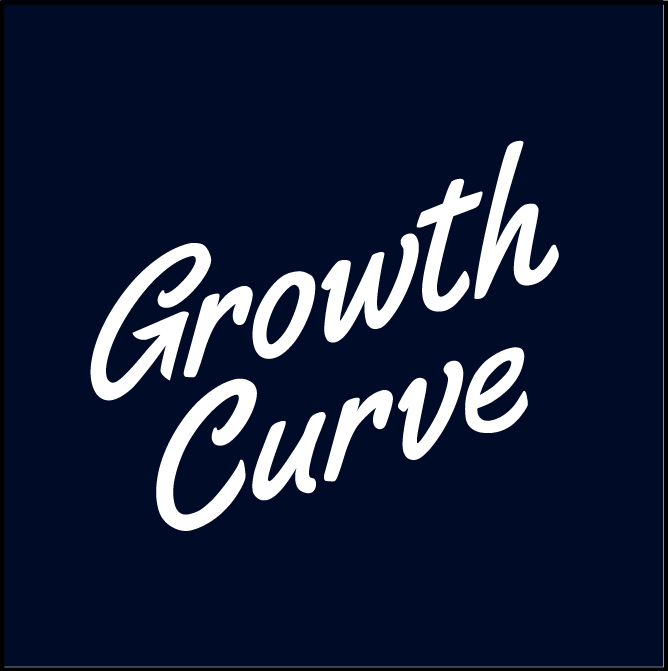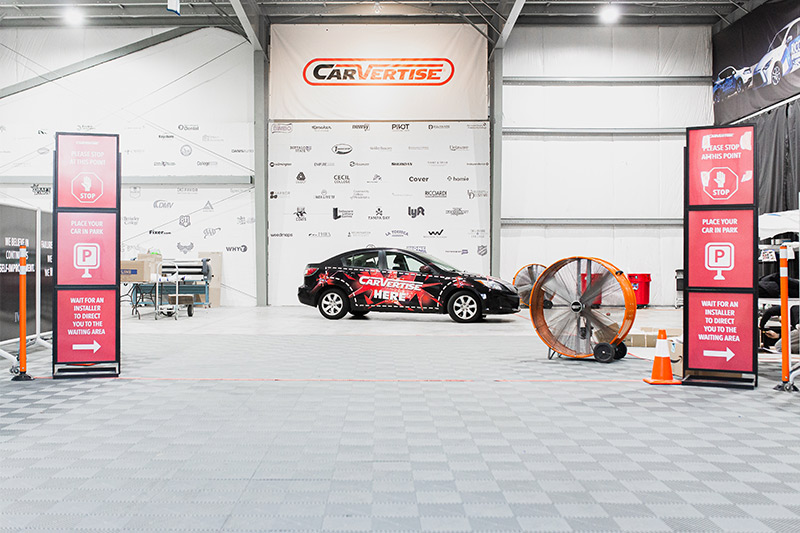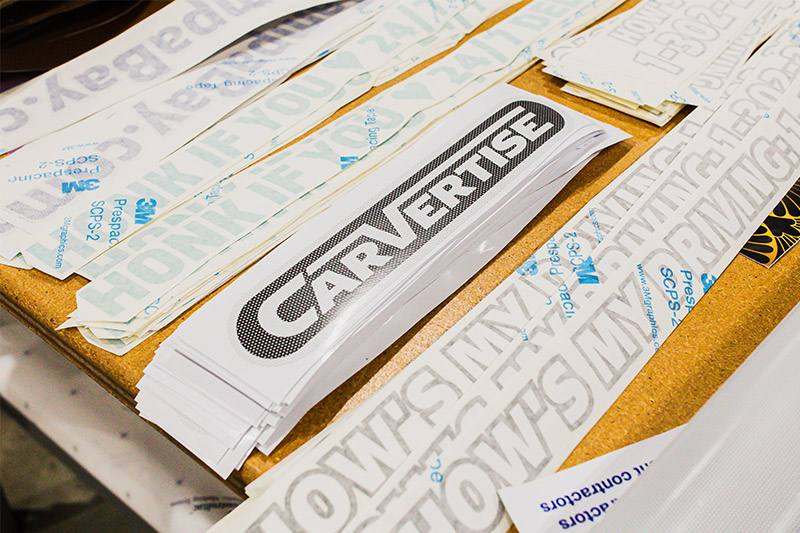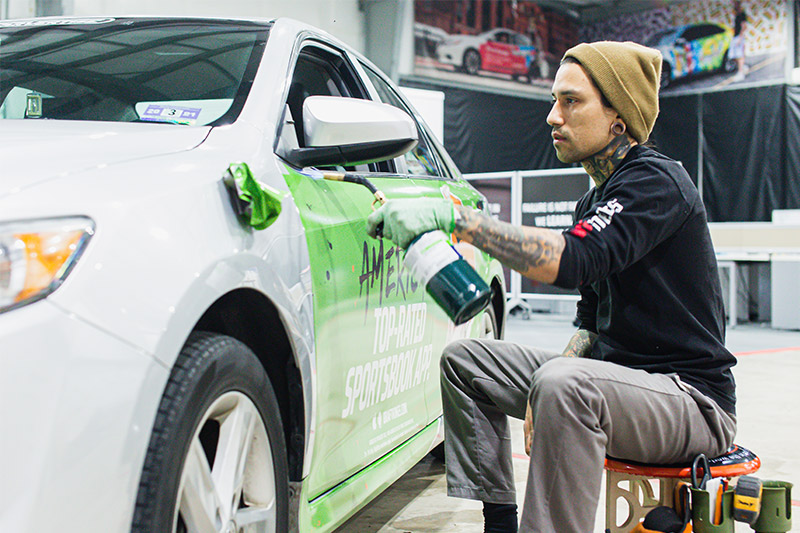March 2, 2020
An interview with Greg Star, Founding Partner of Carvertise, a Philadelphia-based startup that created its own media channel by connecting brands and drivers to advertise on cars.
Carvertise was launched in 2012 by two University of Delaware students whose great idea for putting advertising on commuter cars became an obsession that they couldn’t put down. The company has gone from scrappy startup trying to make ends meet to a profitable business at a major crossroads.
On this episode of GrowthCurve, hear from founding partner Greg Star about the beginnings of Carvertise and the big decisions he and his team are preparing to make.
The Early Days
1:15
“You really shouldn’t start a company unless you can’t stop thinking about it.”
Jason: Greg, it’s awesome to have you here on GrowthCurve. Thanks for coming.
Greg: Thanks for having me.
Jason: What were the events that led to the launch of Carvertise?
Greg: I was at the University of Delaware and I had met Mac, my partner now, very casually. Really we met through playing at a post game in college, playing Super Smash Bros. on N64. There’s nothing I’m better in, in life, than Smash Bros. on N64. That’s my true calling. I ended up playing Mac really late at night. I beat him, but he was talking a lot of trash. We kind of met like that.
Greg: He came in to present to my Economics of Entrepreneurship class. He was telling me about what he was working on. It was called Penguin Ads, and it was this whole idea of paying people to put ads on their cars. I was just like, “This is such a great idea.” I was thinking, “How is this not a thing yet?” My mind was just racing. I sent him a message, “Hey, I’m happy to just help out any way I can.” Then we just started working on it, and it just blossomed from there.
Jason: You basically just approached him, and said, “Hey, I’m really interested.” I actually read an old Technical.ly article that said, “Greg’s an amazing worker. His heart is right there with it. He was getting paid peanuts. What was driving him was the vision.” I guess like a lot of startups, you came in, you wanted the experience. What was that vision that you saw, I guess?
Greg: I tell people, “You really shouldn’t start a company unless you can’t stop thinking about it.” Every conversation I’d have with people was in the context of why they should put an ad on their car. I’d think about the University of Delaware, where I went to school. I’m like, “Why can’t the school pay all these students to wrap their cars for the school? It’s a win-win.” I’d go to the Knicks games. I’m a Knicks fan. I’d be like, “The Knicks should pay all their fans to wrap their cars for the Knicks.” Everywhere I went I would talk about it, and I would view the world through that prism of how much opportunity there was. I was doing other things, but it was all relating back to this. That was kind of like a sign of, “I should probably just keep doing this.”
Jason: So you were pretty obsessed…
Greg: Oh, yeah.
Jason: …if everything was connected to this. When you get into something, are you just completely absorbed in it, or is that how you know that this is-
Greg: I think it’s both. I think I get a lot of questions on, “Oh, I want to start a company. Should I?” I use that as the baseline. Unless you can’t stop thinking about it, because that’s the amount of energy you’re going to need. Then you should do it, but if not, there’s other things you can do to fulfill yourself. I get pretty obsessive over things, probably not in a healthy way. It’s just my personality.
Jason: The company’s less than six months in, at that point, when you joined?
Greg: Yeah. I think Mac was working on it during that summer. Fall of 2012, I kind of jumped in. Yeah, it was pretty nascent.
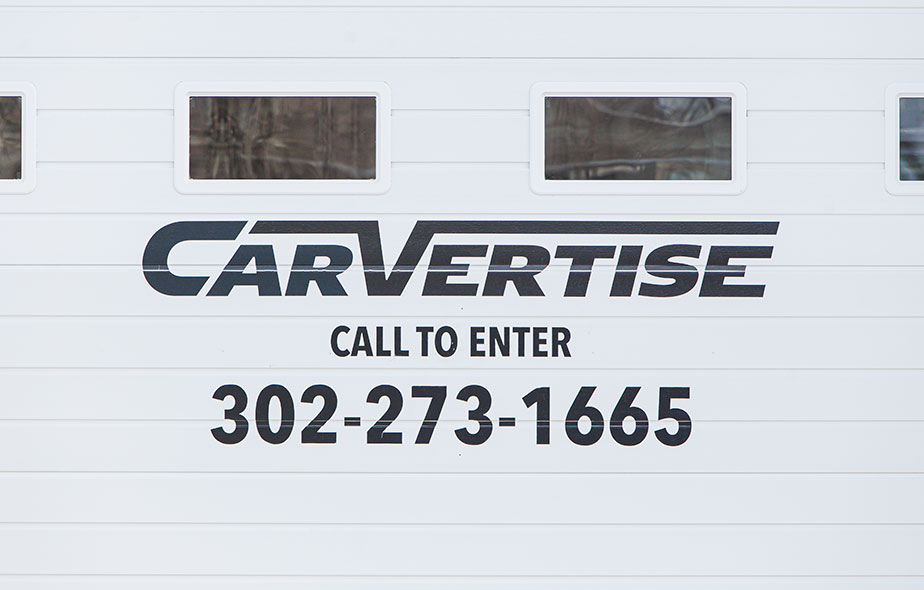
When in Doubt, Start with Google
4:14
“I knew that I couldn’t just sit behind my computer and hope. I knew I had to meet people. So I Googled important people in Delaware.”
Jason: What was that like to acquire the first couple of customers?
Greg: What I did is I made a list of people to know in Delaware. We were University of Delaware students. I knew that I couldn’t just sit behind my computer and hope. I knew I had to meet people. So I Googled important people in Delaware and I looked at people who are on the boards of universities, boards and nonprofits. I sent them a message, “Hey, I have this company idea. Would love your help. Let me know if you’d be able to meet.”
Greg: I reached out to like 25 people. A few of them got back to me. One of them was the Cabinet Secretary, at the time, for the State of Delaware. He took a meeting, and then he’s like, “You need customers.” He put me in touch with the local ShopRite CEO. I go to that meeting with the local ShopRite CEO. I didn’t know this, but it turns out he’s the toughest negotiator I’ve ever met, even seven years later. He is a shark. I say that in a very affectionate way. Now he’s an advisor to the company. He adds a ton of value.
Greg: It was terrifying. I go in this meeting and he’s just beating me down on everything. I think he took enough pity. Because the Cabinet Secretary was like, “Hey”… He probably took it like, “I should probably just throw this guy some business.” Our first customer was ShopRite. Once we got ShopRite, then others started coming into the fold.
Jason: Was your sort of offering and pricing structure very different than it is now, back then?
Greg: It wasn’t that different. It’s different, but the basic unit of charging on a per car, per month basis, it was there. I think we lost money on this first deal, or maybe we just broke even. We needed something.
Jason: Yeah, and you got a big name brand, too. It’s very recognizable.
Greg: Oh, yeah. We’ve been working with ShopRite the last six years. Then we got into their mother corporation, Wakefern, and we worked with them. Then we got other grocery chains. It definitely worked out.
Jason: Okay. When you got that first customer and it was ShopRite, were you able to use that as a platform to pretty quickly get the next few customers, or was it still a struggle, the next?
Greg: Oh, still a massive struggle. The early stages, the way we were getting customers, was through just networking. One thing I did is, I looked at the Governor’s public schedule in the State of Delaware, and I just started following him around. Because I knew wherever he went, decision-makers would go, and executives would be there. That’s the only way I was going to be able to meet them was, “The Governor’s doing a ribbon-cutting at AAA.” How else am I going to meet anyone there?
Greg: Two years of going everywhere, all the time, and trying to get a face-to-face. There was a lot of pressure, because you’d have a minute to be like, “Look, young guy, like company, we’d love your help. Here’s the idea. You should be helping startups. Come use us.”
Jason: Nice.
Greg: So it took a while.
Jason: He was kind of like a spokesperson for you, in a way, a little bit.
Greg: The Governor? No. He puts his schedule on publicly. I would see where he was going and I would just follow. I would literally go where he was going. He didn’t know me, but I would just show up to events that he was going to. His bodyguard started to know me after a while.
Jason: He started to realize you were kind of… Recognized you.
Greg: Some weird dude in glasses. And just like, “Who is this? Who is showing up?” I actually learned a lot though. I learned a lot about press and how you can spin a lot of like, “Big announcement about this partnership,” which doesn’t really mean anything, but it’s a partnership. That was how we’ve learned how to get press, too. It was fun.
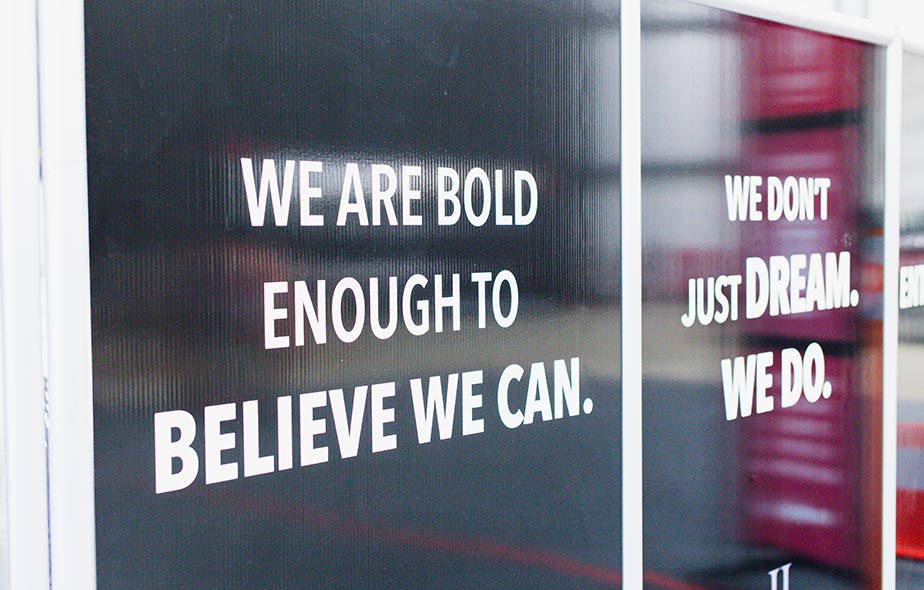
2012 - 2013: The Dark Ages
7:20
“It was a cascade of last-minute deals and loans. It was very messy, but we just kept going.”
Jason: That’s what, 2012, 2013?
Greg: Yeah. It’s around that. Honestly though, I like history a lot. Like probably the dark ages, I’d say. We’re in history. Right? Like the dark ages was like 2012 to 2013. Then 2014 to 2016, I don’t know how we… I say I kind of blacked out. I have no idea how we were able to make it 2014 to 2016. It was just a cascade of last-minute deals, of loans. It was very messy, but we just kind of kept going.
Jason: What was the challenge? Was it a new idea that was taking time to get people to-
Greg: Yeah, totally. You go and pitch somebody, and they want to see if you’re around six months later. It’s not like, “Hey, I’m going to give you business.” It’s like, “All right.” Good ideas and new ideas take time to peculate. Right? So you pitch something to someone, and they’re like, “Interesting, yeah.” Then they get busy, and then three months later, it’s like, “Oh, yeah. Just hold on a second.” Then it turns out it’s nine months from the first time you met them. They’re like, “Yeah, let’s do this.” It just takes time. We’ve had deals that have taken three years. That was a lot of it. We needed money but people aren’t ready to just buy a new product right away. They have to sell it internally. You also have to find someone who’s an innovator, who wants to try it. It was a lot of that.
Jason: Tell me some of those assumptions you had going in with the business, that over that period from 2012 to 2015, you realized, “Oh, this is not how it’s going to work.
Greg: I thought it was such a no-brainer. I was like, “Why wouldn’t you want to do something different and stand out?” I just realized that’s not how most businesses operate. There’s a system. There’s a formula, and by following that formula, you don’t get in trouble.
Greg: I had a lot of trouble. I was like very frustrated. It didn’t click to me that when you’re disrupting, you’re creating friction and not everyone likes that friction. You’re changing behavior, people’s buying behavior, which is a really hard thing to do. Also, this is more later on, I came to the conclusion that your product is not right for everyone. So everyone I was talking to, I was like, “This makes a ton of sense for you,” but I was biased in my personal view. I think maturing over time to realize this is not for everyone and you need to just hyper-focus on who this really makes a ton of sense for, instead of just going after everyone.
Jason: Obviously, you have some customers that are just not going to go against the grain. There’s not going to be a champion internally that’s just going to say, “This is new, let’s try it. Let’s be innovative. Let’s put some experimental budget to this.” You probably saw certain profiles of companies that seemed to jump in faster than others. What were you seeing during that time?
Greg: The company had to be big enough. This is another lesson learned. They have to be big enough to have a consistent advertising budget. Like going to like a local mom and pop, whose spending 300 or 400 bucks a month, are not our target customer. That’s took a while to realize, too. We’re based in Delaware, also. There’s not a lot of big companies there that spend money in advertising. That was also a struggle, too. We’d go in and pitch and they’d be like, “Our annual budget’s like 25,000.” We’re like, “Okay, we’re not a good fit for you.” They have to big enough to spend consistently.
Greg: Then it was, they have to spend money on out of home. They have to believe in the power of out of home. Then it goes back to the person. The person has to have certain qualities, where they’re high enough, where they can make decisions. They’re innovators. They’re in a competitive market where they need to stand out. It was a combination of those factors we realized, was the perfect kind of customer profile.
Host's Commentary
11:25
Greg hits on a few really important points in this episode. As a B2B startup with an innovative offering, time is not on their side. For anyone launching a new business like Carvertise, it’s not just about being obsessed with the idea – that’s just the baseline as Greg says. The more difficult part is enduring through long sales cycles and waiting for the market to warm up to a new idea, then growing city by city. Now 6 or 7 years in, Greg understands it’s a 15 year ride. Would Mac and Greg have launched this business back then if they knew what they know now? It takes a certain kind of entrepreneur to want this kind of journey – and perhaps too much emphasis is placed on the massive fundraising hockey stick growth trajectory startups that want to cash out as quickly as possible. Carvertise is a different kind of startup story – and the big decision they face is whether to stick with their current identity or shift into the fast lane. And we’ll come back to that later.
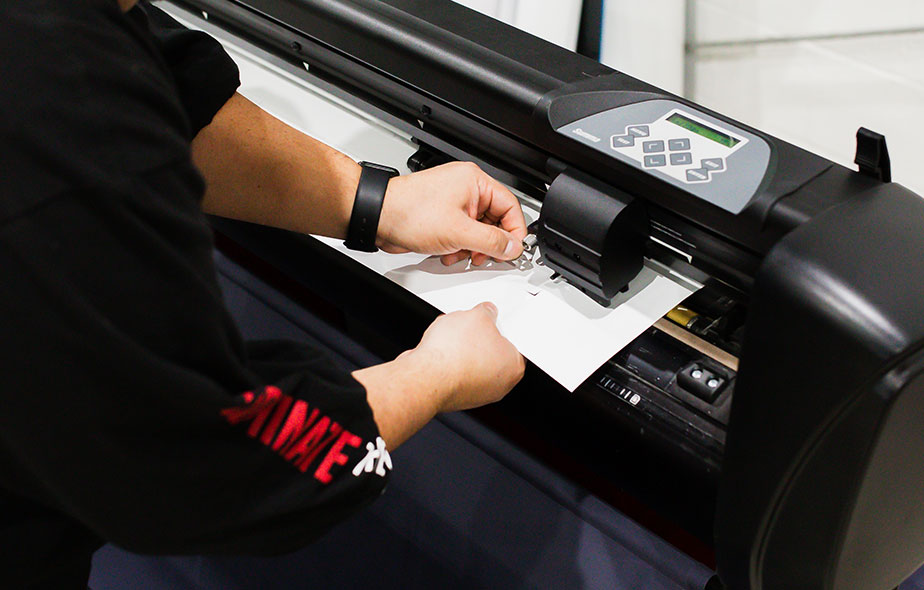
The Evolution of Ride Sharing
12:21
“When you’re disrupting, you’re creating friction and not everyone likes that friction.”
Jason: Let’s talk a little bit about how the offering has evolved. I see ride sharing. I didn’t see that originally.
Greg: Yeah. That wasn’t there.
Jason: Tell me how the market has evolved and how you guys have kind of evolved.
Greg: When we first started, it was really only us in the space. It was just putting ads in everyday people’s cars. As Uber and Lyft started to take off and take over the world, customers started asking us, “Can we get a driver that’s driving for Uber and a driver that’s driving for Lyft?” We were like, “Yeah.” After a while, we were like, “Why don’t we just separate those two? And say like, “Here’s our package for ride share drivers, and here’s our package for on-the-go drivers.” Just people in suburban areas and things like that.
Greg: That was a major shift. From there, we offer, now, advertising at specific events. Having ride share drivers picking people up at sports games, at conferences, and things like that. That’s becoming huge. We’re offering a digital retargeting aspect to the cars, where they can capture device IDs of people who are around the car, and then send digital ads back to them. Then you’re able to track, click through rates and attribution for actions that are taken. The product’s really evolved. The creative has evolved. We went from, “Let’s put anything on the cars” to “We have standards.”
Greg: We’ve turned down clients who’ve wanted to put things on the car that we know would not elevate the brand and elevate the medium. That’s really important to us as well. There’s been a lot of progress on every aspect of the business, but the basic fundamental is still there. We’re still outsourcing people to turn their car into an ad. We just know a heck of a lot more on how to do it and how to make it effective.
Jason: If you were to evolve the product offering, where would it go, in the next few years?
Greg: We have some ideas. Everything is very customer-focused. It’s the same way we figured out ride share drivers is appealing. It’s listening to them and asking them what they would want and going from there.
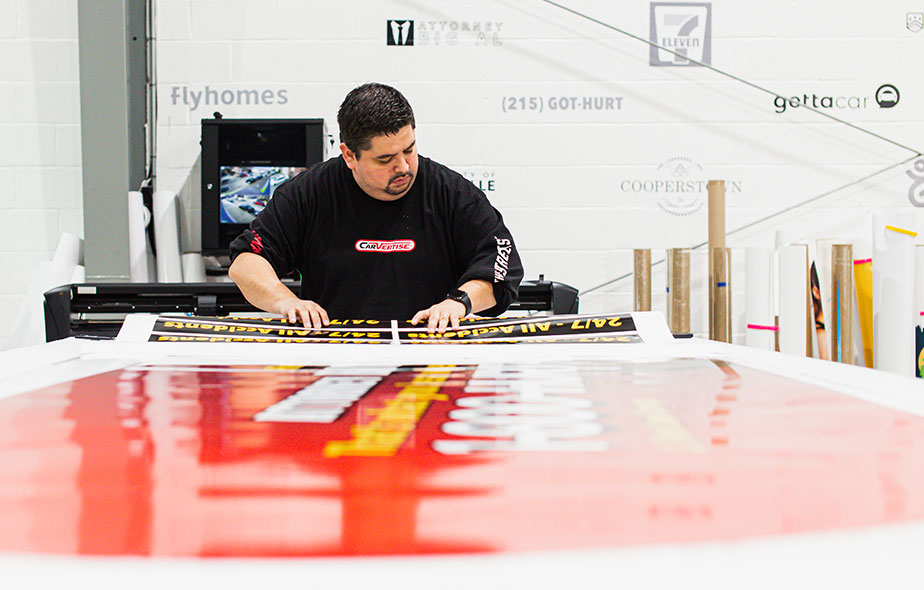
2014-2015: The Industrial Revolution (and an Unlikely Investor)
14:24
“We went from ‘Let’s put anything on the cars,’ to ‘We have standards.”
Jason: All right. You talked about the dark ages, Obviously, at a certain point, the dark ages weren’t the dark ages anymore, or they weren’t so dark. Then you came out.
Greg: The industrial revolution.
Jason: Tell me what helped you? What were some of the events that helped you out of that?
Greg:The key turning point was when we got our domain name, We were called Penguin Ads when we started the company. It’s because penguins are cool. We always thought the name of this industry was Carvertise. Right? Car advertise. Not Carvertise.net, but you needed Caradvertise.com. The challenge is someone had Carvertise.com. They had what we thought was like the golden domain name. We were reaching out to him. The email was dirtworshipper9000. That’s the guy’s email, who had the domain name. We’re reaching out to dirtworshipper, “Hey”… We’re using fake aliases. We’re having advisors send him letters on our behalf. We reached out to them for like four or five months. He doesn’t answer. One day, he answers back one line, “$10,000.” Right?
Greg:We were in college at the time. We didn’t have that, but we were like, “Yeah. That that sounds good, and let’s meet up. Where are you?” Then he goes cold again. This was on Good Friday, 2014. My partner is like, “I can’t do it. I need this domain name. I’m going to go find this guy and go see his house.” He plans to go find out where he lives, look at the value of his house. It didn’t add up. He lives in Cary, North Carolina. The value of his house is only $110,000. He’s getting roughly 10% of his household income and he’s not answering. Something’s a little off. He decides to drive down and see him in person, just like surprise him. I was like, “You should bring your mom with you because it’d be less threatening. If you just show up”…
Greg: His mom’s awesome. So they drive to Cary, North Carolina, show up at like 10 P.M., knock on the door. This big guy answers. He’s like 6’2″, 250. My partner’s like, “Hey, I’m Mac. I’ve traveled all this way to see you. I would love to get 10 minutes of your time, to buy the domain name.” It turns out this guy made a fortune in the 90s buying and selling domain names. He just loves mountain biking. He lives alone and a quiet life. He said he thought this could be huge also, but he didn’t want to sell it for just $10,000. He’s had the same vision we had.
Greg: So negotiation ensues, where he’s like, “Look, you give me a piece of the company, I’ll give you the domain name.” What ends up happening is there’s a negotiation between Mac and this guy, Dave Butler, and Mac’s mom is the mediator, being a neutral arbitrator. They talk until 2 A.M. They eventually agree that night, he’d give us Carvertise.com, trademark name to Carvertise, and $50,000 in exchange for 5% of the company. That’s what they walked away with.
Jason: Oh, so you got funding from him.
Greg: Yeah, funding, and the domain name. So that was the turning point.
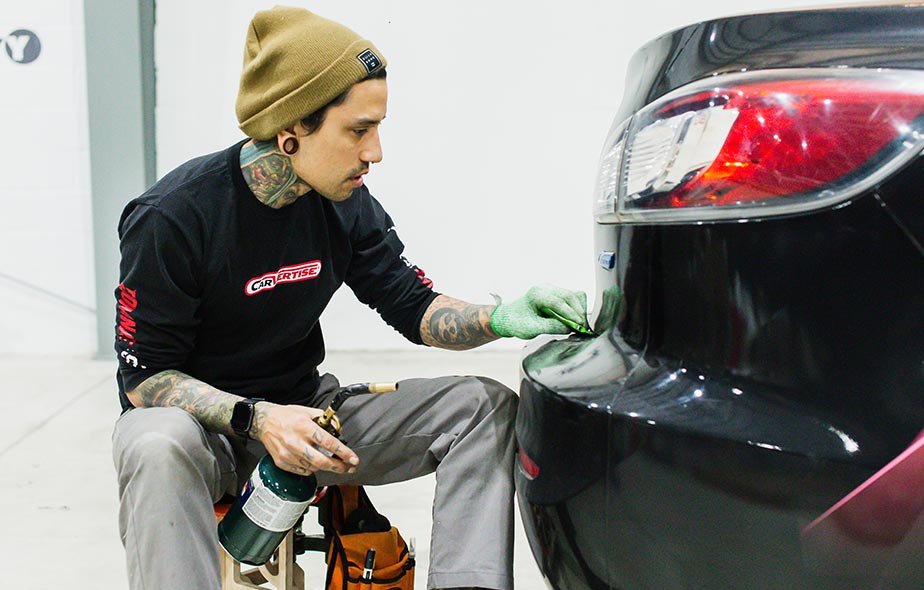
Startups Need to Raise Money, Right?
17:23
“You spend all this time raising money and then if you don’t know what you’re going to do with it, you waste a lot more time.”
Jason: Not what you expected, I guess. What did you expect going down there? What did Mac expect?
Greg: He’d just had no clue.
Jason: No idea?
Greg: No. That was a pretty good scenario. I don’t think he expected that. I got in a car accident that day, funny enough. I was working one of the part-time jobs I had, and I got in a car crash. I remember him calling me, “How’s your day going?” I’m like, “I got in a car accident. What do I do?” He’s like, “Well, I’ve got a story to tell you.” It’s pretty funny.
Jason: Mac’s mom was instrumental in all of that.
Greg: Huge.
Jason: Is she an ongoing advisor for you guys?
Greg: Yeah, she’s our number one cheerleader. Yeah, she’s been great.
Jason: That’s awesome to have. From 2014 to 2019, you guys have grown a great deal. It seems like, from what I can tell. You went from ShopRite to a number of large regional brands. What does that look like? What does the average deal look like? Can you take me through a couple examples? Like case studies almost, of a couple of those customers?
Greg: The average deal size is between 20,000 to $25,000 campaigns. Typically, a customer will have a need in a specific geographic area. They’ll have an offering of like… If they’re a college, for example… We do a ton of work in education. “Hey, we need to promote this MBA program in Philadelphia and these four counties surrounding it.” So we’ll give recommendations, like, “Hey, if you want to hit Montgomery County, you should get 15 cars. That’ll make a dent. That’ll make a difference.” So they’ll put 15 cars for a seasonal push, promoting something, and then the cars come off the road like that. That’s a very average campaign for us. We’ve had deals that are as big as $650,000 to deals that are as small as a thousand whatever dollars. There’s a range in there, but that’s the kind of average.
Jason: Between 2014 to 2018, did you have the need to raise money?
Greg: We raised a little bit of money. We thought like every startup, “We need to raise money.” There wasn’t that much thought behind it. We tried raising 500,000. It took us eight months. We ended up raising like 150,000. The best thing to happen to us is we didn’t raise more money, because we had no idea what we were doing. We had raised 150,000 and then two months later, we need an emergency 25,000 just to stay afloat. It shows you how good we were with money. I think the best thing out of that whole experience was… We were so lucky to have such great investors. They’ve been so helpful in guiding us and being patient. That money we raised, we really wasted 80% of it. But the people who are now in our corner as a result of raised the money, have provided insane amounts of value. It was a very good thing that we did end up raising money, just to have them kind of in our corner.
Jason: Since then, everything’s been pretty organic, revenue?
Greg: Yeah, everything’s been organic. Yeah.
Jason: At what point do you feel like that might need to change?
Greg: Like now. We’ve grown. We grew 300% last year, and then we grew another 80% this year, organically. We’ve had a lot of good growth, the last two years. More people are jumping into the space. There’s kind of a turning point where we’re like, ” Okay, is this a lifestyle company? Which is great. Right? Or is this like a scalable model that we want to try to exit?” And so we’re figuring that out. Right?
Greg: Is there an in between? That’s kind of what we’re working on. One of our early investors, he’s really big on the fact that raising money can be really distracting. You spend all this time raising money and then if you don’t really know what you’re going to do with it, you waste a lot more time. It’s why you hear all these stories of startups that were just super focused on what they knew, building it. They end up winning in the end because they’re hyper-focused on what matters.
Greg: We’re very cognizant of the fact that… Raising a few million sounds cool, and there’s a lot we could do. But until you’ve really proven out, you know for sure, you could end up shooting yourself in the foot. Just our thought process. We started this, we didn’t know what we wanted, what we were doing. It was just, “Ads on cars. This is the thing.” Then you grow up and realize like, “What’s the point? What’s the end?” Yeah. It’s just kind of figuring that out. Fortunately, we’re in a position where we’re flexible. We don’t need to raise money. We have a profitable business. There’s flexibility and we’re having fun. There are outside factors that are contributing to why we’re having this conversation now. But for the most part, we’re very thankful to be in a position where we don’t have to raise money to stay alive, is the point.
Host's Commentary
22:08
Profitable, Flexible, Fun. These are the words that Greg uses to describe Carvertise at the current moment. He realizes that raising money could be the best thing for the business, but will likely alter the company’s identity and dramatically change the day to day approach. Hopefully the fun part doesn’t go away, but profitability and flexibility certainly will, at least in the short term. Once you take the money and shift into the fast lane, the pressure is on to go big and multiply, even if things are messier or you lose some of your warm and fuzzy startup vibe. I am wondering whether Carvertise will decide they are the organic B2B advertising company, satisfied with strong growth and a healthy profits, or if they are the fast scaling ad platform – they are at a major crossroads that will completely define their future.
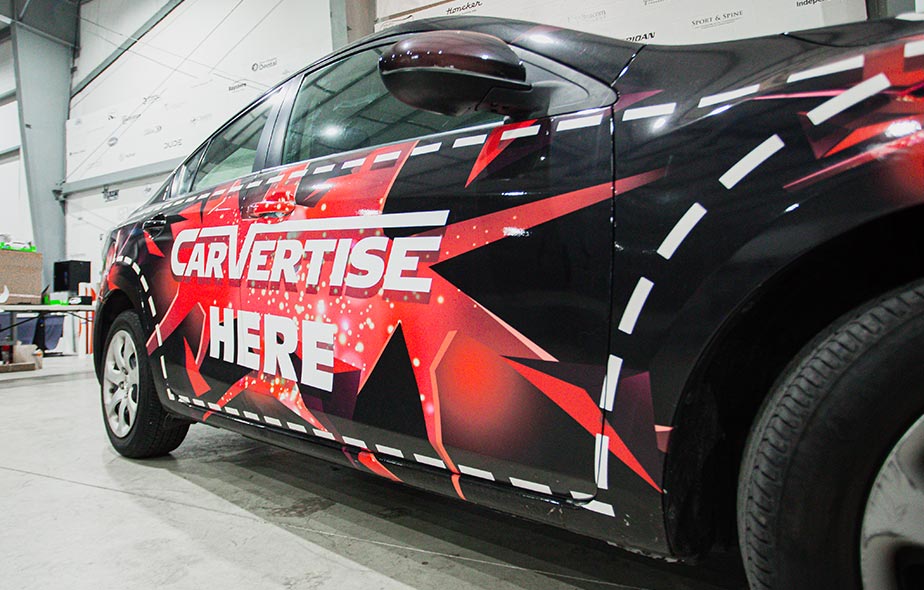
The Market is Heating Up (and That’s a Good Thing)
22:46
“There’s more people jumping into this advertising on car space, which is a good thing. If this isn’t a hot market, there’s kind of a cap on where this can go.”
Jason: So if you don’t mind me asking… I guess that’s my job. What are these outside factors that are making this conversation happen now?
Greg: First off, there’s a ton of capital out there. There’s a lot of easy money. People are looking to park their money on things. I think we built a pretty good track record, where if you think, “Money’s easy. Right now we have a good track record. Should we lock up a few million dollars, just to have it in the bank to do things?” There’s market conditions on that end. There’s more people jumping into this advertising on car space. There’s people advertising on top of cars, on the side of cars, which is a good thing. If this isn’t a hot market… There’s a kind of a cap to where this can go. It’s like, “Other people are jumping in. Do we start to really push the gas to help kind of lift the market feasibility of this industry, as a whole?” Those are the factors we’re kind of considering right now.
Jason: Are there specific competitive pressures, too? Is there single or multiple competitors that are stepping on the gas right now, that you feel-
Greg: Yeah. They’ve all raised a ton of money. Yeah.
Jason: But you still feel like you are leading the charge in certain ways?
Greg: Yeah. In certain ways. We’ve been at it longer than anyone else and we have a defined strategy and a defined lane. I feel good about that. To raise that much money, there’s going to be a lot of learning that goes into it. Unless there’s a potential to really lose our clients. I don’t think that there’s that much of a need. But if we’re starting to see clients that are leaving us, that’s when it’s, “Okay, it’s time to kind of really tool up, to prevent this from happening and to go on the offensive.” I don’t know though. That could change tomorrow.
Jason: It sounds like raising capital right now is more of a preventative. If we need to. If things happen that show us that we clearly need to. It doesn’t sound like an aggressive, “We have to, to grow right now” kind of situation.
Greg: No. We can grow pretty good, organically. We can grow faster, if we took on money. It’s all time. And our lead investor is always… He’s had his company for 30 years. It’s like a 100 plus million dollar company. He owns 100% of it. It’s really fun talking with him because we’re in such a hurry. We’ve had this conversation every three months like, “Hey, we should raise money. Let’s go.” And he’s always like, “Why? Wait four months and see how this turns out.” We wait four months. We come back to him, and he’s like, “Well. What’d you learn?” We’re like, “We learned a lot.” He’s like, “Okay, good.” And so we’re like, “Well, maybe we should raise money to do this.” He’s like, “Well, do that on a little scale and then just wait and see how it goes.”
Greg: We have that same conversation every quarter, essentially. The way he looks at building a company… He’s not looking at a very long-term play, where you’re steadily building brick-by-brick and piece-by-piece and it compounds over time. He’s like, “If competitors jump in, that’s fine. There’s always competitors. Don’t worry about it. Just keep plugging away.” Having this conversation, I’m like, “Yeah, we should go faster.” “We should slow down.” We’re having a lot of conversation, with a lot of smart people about it. So we might.

Better Coverage, Better Culture, Better Company
26:17
“You need a great culture to build a great company. It’s not losing sight of people. It’s creating an environment that’s friendly, that pushes people.”
Jason: Are there any factors with the difference between the early startup stage and now? You guys went through, you said multiple years of like 300% growth. The company obviously changes. You guys grow as people. Are there any factors? How has the culture or the business changed, and has that put any pressure on you guys, in this decision-making?
Greg: I think the culture has gotten a lot better. I think we’ve matured as operators and leaders, and that’s been important. Yeah, it’s been tough. We’ve had to let go of early employees and the composition has definitely shifted. That’s like any growth company. There’s always change. You’ve just got to be super optimistic about every change that happens, that you don’t expect. But, no. I like our team. We were able to write health insurance for employees. People are getting paid market rate, above market rate. We’re happy about that, and we’ve created a very close-knit company. And taking on money can change that. Right? It could also change it for the better.
Jason: Well, you have options. That’s a good thing. So with this conversation, it sounds like part of it is kind of crystallizing, like that three to five year plan. Could you share with me what you think that looks like right now?
Greg: It’s investing. It’s really basic. We have a sales team. We just hired our first head of marketing. It’s just doubling down on those two things in a way that we know works. It’s consistently improving the product, so that our clients are getting better coverage, better exposure, better metrics, better results. And it’s continuing to focus on building the culture. You need a great culture to build a great company. It’s not losing sight of people. It’s creating an environment that’s friendly, that pushes people. That’s the basic.
Greg: It’s so funny. I watch a lot of sports and you hear these interviews after the games with coaches, and you’re like, “What are they even saying?” They’re just saying words that don’t mean anything. I feel like I now sound like that because I say things like, “We get better every day.” “We just put our best foot forward,” and all these cliches. It’s really true. It’s a very journey-oriented mindset.
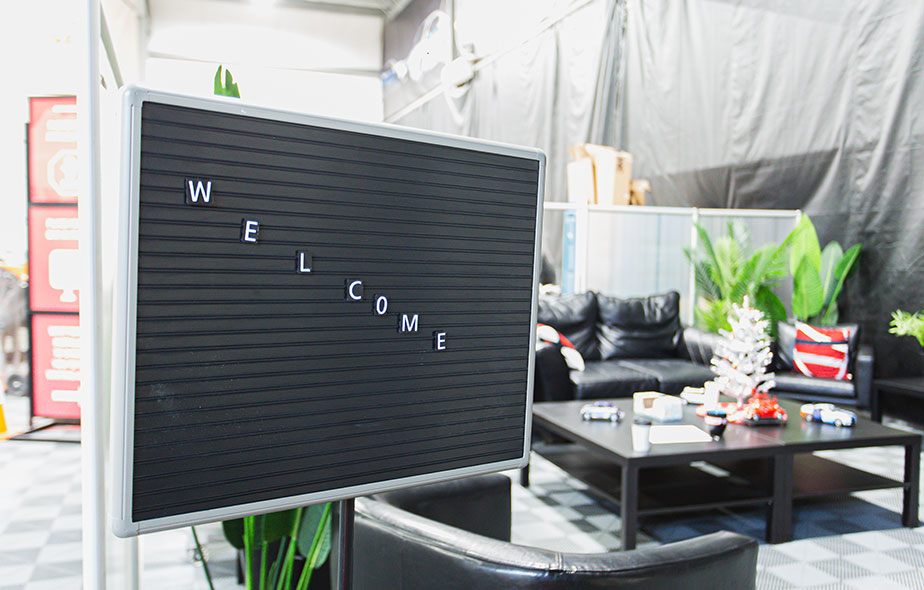
Sales is Marketing, Marketing is Sales
28:37
“We’re big believers in marketing, but with a sales mentality behind it.”
Jason: You could also make the mistake of saying something in the moment that is not actually how you feel over a more elongated period. But then people lock into that in an unnecessary way. I think that’s why very good head coaches and leaders can sometimes sound like that. What types of things are you guys looking at to really understand if you’re headed in the right direction? What specific metrics or goals do you have right now?
Greg: The key thing for us is figuring out… If we hire a salesperson, when will they be breaking even for the company and profitable for the company? How long does that sales cycle take? What’s the makeup of the person? What’s the right compensation structure? So it’s figuring that out that. If you could figure out that, everything becomes a lot easier. “Hey, if we hire five people here, it will lead to this amount of revenue in this amount of time.”
Greg: Then from that’s when you can really just put the gas on it. A lot of the debate about fundraising is, “Are we there yet, or are we not there yet?” Some days, I feel like we’re there yet. Some days, I feel like we’re not there yet. That is the crux of it. Any B2B company’s scale is like, “What’s your sales process like, how long, how much, how sure are you of it, and was your management structure executed?” That’s the big focus.
Jason: Then, how repeatable can you make it? When it gets to that point. I get the sense that you’re hardcore networkers. You’ve got that sales drive. You get into conversations. You get yourself in the door. You and Mac are both kind of like that. Right?
Greg: Yeah.
Jason: So you kind of come from that at the roots. Do you feel like you’re more of a sales-oriented organization, or is it sales and marketing are very connected and unified? What’s the makeup that’s driving the business?
Greg: Sales? Marketing is sales. Right?
Jason: Yeah.
Greg: It’s just selling to a specific group of people. I saw a funny quote. It was like, “A marketer is a salesperson with a degree” or something like that, which I thought was really funny. I really do believe that. The best marketers I found and I’ve come across, they’re fundamentally in sales. They are selling a product and it’s a mindset they have to embrace. Because when you embrace that and you understand that, I think you’re more effective.
Greg: Yeah. We’re 100% a sales organization. I’m selling all the time, whether I’m selling the product, selling to our customers, selling the vision to the company, selling to our vendors about why they should work with… All of that. Yeah. We’re a heavy sales based organization. It starts from the top. There’s different strengths of selling. My partner, Mac, is amazing at selling the vision of the company. He’s amazing at recruiting. He’s great at selling all things. Our head of sales, Jim, is incredible at selling the product and he’s incredible at selling recruitment. Our operations team is great at selling drivers on the opportunity to earn more money. Right? It’s all sales.
Jason: The reason I asked that question, and I don’t mean to like separate the two because they need to be so connected. I’ve been personally through experience of investing more in what traditionally I would see as sales-related roles versus marketing in what I would say is more like an inbound approach. I’ve been much more successful with the latter. I’m just wondering how much of your efforts are invested in building sales teams for more like outbound, outreach, cold outreach, networking, things like that, versus sort of inbound efforts and how has that changed over time?
Greg: We’re spending a lot in marketing as a company. We are big believers in marketing. We believe in our product. We believe in the need for it. I was more referring to the mentality, having a sales mentality. Our brand image is super important. We spend a lot on making sure that every piece of content we create matches with our brand. We spend a lot of money. I’m spending a lot more on social media. We’re putting together a marketing plan right now. Again, we just hired a marketer. We’re starting to get some inbound. We’re starting to put a marketing plan behind every salesperson we hire so that they have support in their markets. Right? Figuring out that right mix. It goes together.
Jason: Yeah, it definitely does.
Greg: I think a lot of companies are blind to the importance of marketing and I’ve seen it firsthand. When you reach out to someone and they say, “Yeah, I’ve heard of you guys,” that sell becomes 10 times easier. Even if they don’t know it for sure, but at least there’s some sort of familiarity. It makes the sales barrier drop completely. That’s why we focus a lot on PR. Like LinkedIn, we’re posting twice a week, everyone. We’re big believers in marketing and I love marketing, but with a sales mentality behind it.
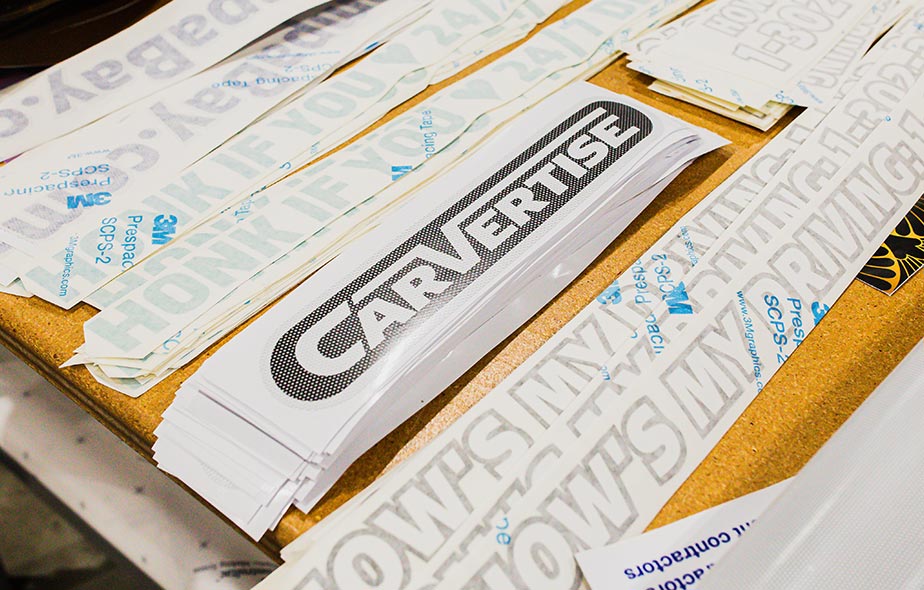
Looking Back and Moving Forward
33:34
“Should is a very dangerous word, in general. It creates expectations.”
Jason: Are there any moments throughout Carvertise’s evolution where you look at it, and you say, “Man, we really screwed that up,” or “We lost a year there,” or “We really should’ve done this differently”? Do you kind of, you say, “Okay, we did it. Let’s move on,” kind of mentality? Are there things that jump into your head, when I just asked that question?
Greg: Oh, yeah. A ton. A ton of mistakes. Yeah, You’ve just got to move forward, and have a short memory. There’s a lot of things I wish I did differently. There’s a lot of time wasted. You have to accept that’s part of the process. There’s no, “I should. I should have.” Should is a very dangerous word, in general. It creates expectations. It creates things that you think you need to be doing but you don’t really need to. Yeah. A ton of mistakes. It can hurt to think about. Again, if you’re looking at things…
Greg: There’s a GrowthCurve podcast. Right? It’s what it’s called, and there’s startups. There’s this obsession with a five-year window of growth. That is insane. It takes 15 years, it takes most companies to get really good at what they’re doing. It takes a long time. The stories that are celebrated are not the 15 year keeping on success stories, but the five-year unicorns. That’s perverse. If you’re able to change your mindset of, “This is a 10-, 20-year experience, and I get there’s going to be mistakes along the way,” you accept it more.
Greg: If you’re obsessed with an unrealistic timeframe that your investors put behind you, who don’t really know, then, yeah. You’re going to freak out. You make a wrong turn in year three, and it costs you six months, you can be screwed, which is another reason why taking on money… It goes back to it. It’s like a car driving. We’re driving car at 50 miles an hour. If you turn, you’re okay. But if you’re driving the car at 150 miles an hour, you hit a bump, you’re flying off the road and you’re screwed.
Host's Commentary
35:48
Back to the speeding car analogy — what Greg hits on here is that every decision made at high speed comes with greater risk, and any wrong decision could result in a massive blow that’s hard to rebound from. The decision to speed up or continue cruising comes down to what Mac and Greg want their future to be and whether they think this is a zero sum game or an industry that allows for multiple successful businesses. They absolutely do not have to give into the traditional cliche of being a VC backed unicorn if deep down that’s not who they are. Carvertise will continue to grow and thrive as a profitable B2B business, and perhaps taking on debt is a better way to fund a more established business and keep equity and control. If Carvertise does go out to raise VC funding, valuation will matter a great deal more, and I wouldn’t be surprised to see an aggressive push towards more of an advertising technology platform or marketplace play for Carvertise, as a way to drive a higher multiple. For me, everything comes back to whether Carvertise is a sales-oriented B2B company selling ad inventory and prioritizing fun and flexibility, or will they become morph to become something venture capitalists crave.

What’s Next for Carvertise?
36:46
“If I’m able to make a salary and have fun with what I do, I’m thrilled. The rest is just gravy.”
Jason: What are you personally most excited for right now? Looking at the next year or so for Carvertise. With your situation and I guess you just moved to New York recently, and life changes. Right? What are you looking forward to that’s coming up for the company?
Greg: A lot. I still don’t know what we’re doing next year. So figuring that out, continuing to help our customers and build verticals. Someone said to me once, they’re like, “If you could have fun running a business and give yourself a salary, you should be super proud.” That’s great. That’s amazing. You know? I always keep that in mind. If I’m able to make a salary and have fun with what I do, I’m thrilled. The rest is just gravy.
Jason: Well, the fact that you guys are in that next phase, too. You’ve made it through. You’ve survived. It’s okay to say that, use that word. You got through the dark ages and you guys are a really viable company. The fact that you’re sitting there talking about, “We could use money, but we don’t need it, and we’re profitable.” What you’re saying right now, it’s amazing where you guys are.
Greg: Thank you.
Jason: It may be more uncomfortable for you, the fact that there aren’t these glaring… There’s not a whole lot to pick at and it’s like…
Greg: There’s a lot.
Jason: I’m sure there always is. A lot of the companies that we’ve interviewed on GrowthCurve have been some of those early stage companies, like you guys in 2014, and 2013. We hear a lot of those people going through those early stages of “I need to raise money right now or I might not be around in six months, or three months.” “We’re still trying to find product market fit.”
Jason: You guys represent kind of that next stage of what a lot of these early founders are looking for. You’ve given some advice along the way, but for companies that are like you guys in 2014, are there specific things that you would call out that, you know, “One foot in front of”… Not the most generic things. But are there specific things that you-
Greg: I would say, if had to back to 2014 us, and for startup young, early startup companies, I would just really emphasize the quality of people around you is the best indicator of success. Really work to develop relationships with the best advisors you can think of and put a lot of energy into that. Justin Goldman, he was the CEO of Zoomer, and now he’s got another startup. He said something to me that really changed things, where he was like, his first company Zoomer. He’s like, “I never had a Yoda. You need someone that’s going to be like your backstop, who you have such a close relationship with and then you just over-communicate, over-communicate.”
Greg: If I had to go back to the 2014 me, “Okay, we’re starting out. It’s really build relationships with quality people that can take your company to the next level and don’t lose sight of that.” Right? That’s super important. Every successful company, the founders, they’re all just talking about how great people they have and how great advisers they have. It’s hard to lose sight of that when you’re obsessed with building a product and all this stuff. I would say like just triple down on quality people that can elevate you and the company as the focus.
Jason: I really appreciate the time you spent with me today. Are there any other things that you would like to chat about that we didn’t touch on?
Greg: Check out our website, Carvertise.com, if you want to advertise, or if you want to earn extra income for just driving. We’ll hook you up. Check us out.
Jason: Are there specific roles that you guys are hiring for right now?
Greg: We’re going to be hiring for more salespeople soon. We’re going to be hiring on the operations side probably soon and we might hire someone on a data component of the company as well soon. But those are all coming soon, I guess.
Jason: To be determined?
Greg: Yeah.
Jason: All right. Go to your website and keep track of that or check in with…
Greg: Actually, no. We have that information on our website.
Jason: Just follow our social media channels.
Greg: Yeah.
Jason: All right. Awesome, Greg. I wish you guys a lot of luck. It sounds like things are going well. I’ll definitely love to check in sometime in the future.
Greg: Thanks for having me.
Newsletter
Stay connected with all things GrowthCurve
and get updates as new episodes launch.
